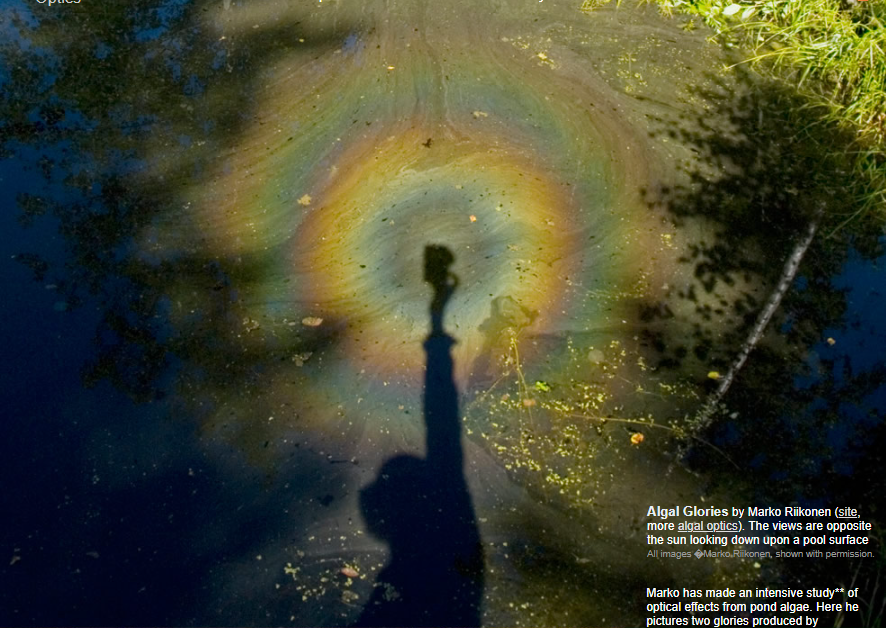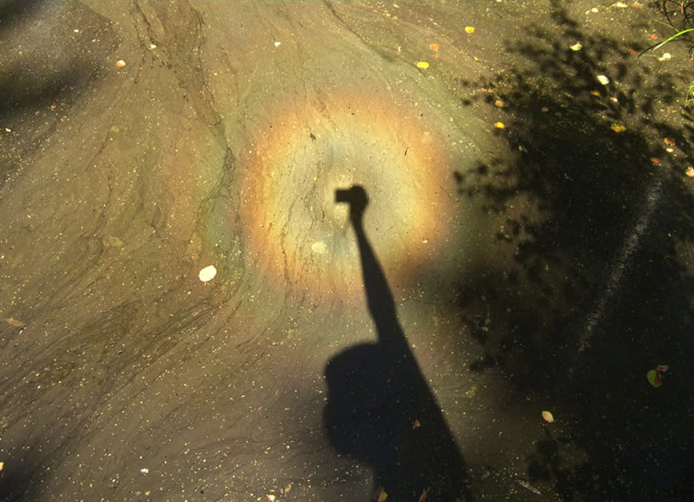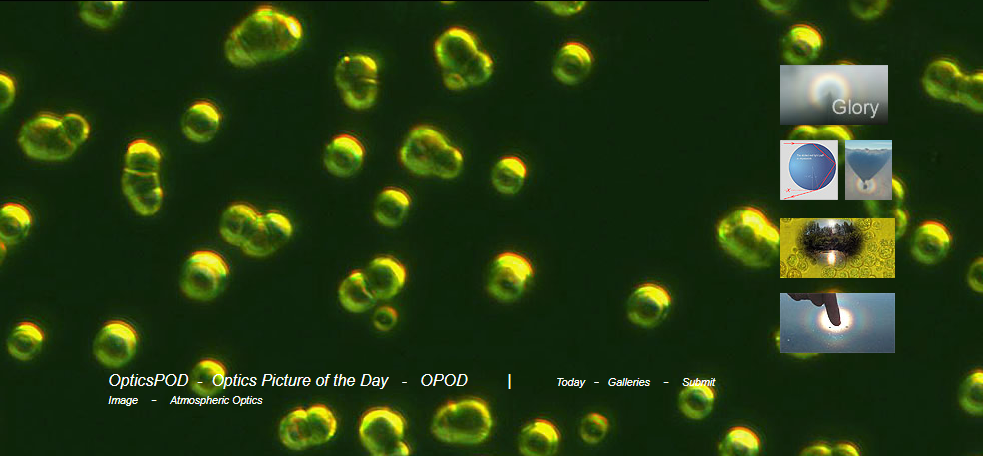Algal Glories
Algal Glories: A Closer Look at Optical Effects from Pond Algae
When it comes to atmospheric optics, there are fascinating phenomena that occur in nature. One such phenomenon is known as "Algal Glories." These mesmerizing displays of light and color are produced by Chromophyton algae floating on the surface of ponds. In this article, we will delve deeper into the intricacies of algal glories and explore the science behind these captivating optical effects.
What Are Algal Glories?
Algal glories are optical phenomena that resemble shimmering rings of light and colors. They are similar in appearance to their counterparts seen in clouds and fog droplets, known as coronae. However, unlike coronae, glories require partially transparent globules with roughly spherical shapes to form. The wave paths of light travel and reflect inside these scatterers, creating the stunning display of algal glories.
The Role of Chromophyton Algae
Chromophyton algae play a crucial role in the formation of algal glories. These algae possess a degree of transparency, allowing light to pass through them. Additionally, their globular portions are conveniently elevated on stalks above the water surface. This unique arrangement enables the wave paths of light to interact with the algae, resulting in the formation of glories.
Exploring the Structure of Algal Glories
The angular size of a glory is largely independent of the refractive index of the scatterer. In the case of Chromophyton glories, assuming a homogeneous internal structure, microscopy studies have revealed a cell diameter of 5-6 microns. This information provides valuable insights into the size and composition of these algae and contributes to our understanding of algal glories.
Unveiling Brightenings in Algal Glories
While not depicted in the images accompanying this article, it is worth mentioning that brightenings sometimes occur on the second ring of algal glories. These bright spots can be attributed to the distribution of chloroplasts within the cells of Chromophyton algae. Chloroplasts are responsible for collecting green light, and their arrangement within the cells can vary with light intensity and the position of the sun. These variations in chloroplast distribution contribute to the unique behavior of algal glories compared to those formed by homogeneous spheres in fog and clouds.
Marko Riikonen's Study on Algal Glories
Marko Riikonen, a researcher from the University of Helsinki, has conducted an intensive study on the optical effects produced by pond algae. His work has shed light on the formation and characteristics of algal glories. Riikonen's images capture the beauty and intricacy of these phenomena, providing valuable visual documentation for further analysis and scientific exploration.
The Beauty and Wonder of Algal Glories
Algal glories serve as a reminder of the remarkable diversity and complexity of atmospheric optics. These captivating displays showcase the interplay between light and natural elements, offering a glimpse into the hidden wonders that surround us. By studying and understanding algal glories, we deepen our knowledge of optical phenomena and gain a greater appreciation for the beauty found in the natural world.
In conclusion, algal glories are a stunning example of the optical effects created by Chromophyton algae floating on pond surfaces. These shimmering rings of light and colors add to the tapestry of atmospheric optics, captivating our senses and fueling our curiosity. Through research and observation, scientists like Marko Riikonen continue to unravel the mysteries of algal glories, expanding our understanding of these enchanting natural phenomena.

Algal Glories by Marko Riikonen (site, more algal optics). The views are opposite the sun looking down upon a pool surface
All images �Marko Riikonen, shown with permission.



Marko has made an intensive study.. of optical effects from pond algae. Here he pictures two glories produced by Chromophyton algae floating on pond surfaces.
His camera shadow marks the antisolar point and the glory centres. The glories blaze with the same shimmering rings and colours as their cloud and fog droplet counterparts.
Unlike coronae, glories need at least partially transparent globules and roughly spherical shapes for they are formed by wave paths that travel and reflect inside the scatterer. Chromophyton oblige with some transparency and their globular portions are conveniently raised on stalks free of the water surface. Marko�s microscope image taken in a sideways direction shows the stalks holding up the globes.
A glory's angular size is almost independent of the scatterer's refractive index. The Chromophyton glories indicate (using a homogeneous internal structure assumption) a cell diameter of 5-6 micron consistent with microscopy.
Not shown here but visible on other images, brightenings sometimes occur on the second ring. Marko attributes these to the effects of the distribution of chloroplasts (the green light collectors) within the cell. Interestingly, these change their distribution with light intensity and sun position and cause the cell to deviate in behaviour from that of the homogeneous spheres of fog and cloud.
..Marko Riikonen, 'Optical phenomena from algal films on the water surface', M.Sc., University of Helsinki, 2008.
Note: this article has been automatically converted from the old site and may not appear as intended. You can find the original article here.
Reference Atmospheric Optics
If you use any of the definitions, information, or data presented on Atmospheric Optics, please copy the link or reference below to properly credit us as the reference source. Thank you!
-
<a href="https://atoptics.co.uk/blog/algal-glories/">Algal Glories</a>
-
"Algal Glories". Atmospheric Optics. Accessed on April 18, 2024. https://atoptics.co.uk/blog/algal-glories/.
-
"Algal Glories". Atmospheric Optics, https://atoptics.co.uk/blog/algal-glories/. Accessed 18 April, 2024
-
Algal Glories. Atmospheric Optics. Retrieved from https://atoptics.co.uk/blog/algal-glories/.